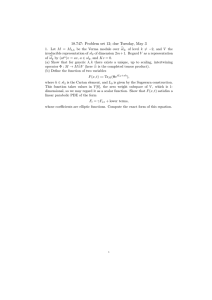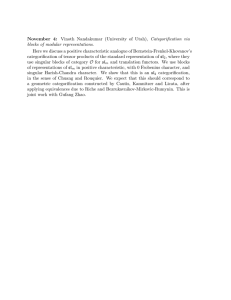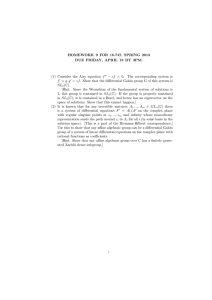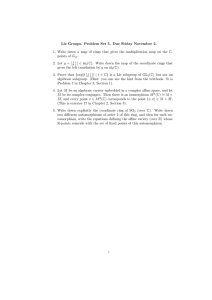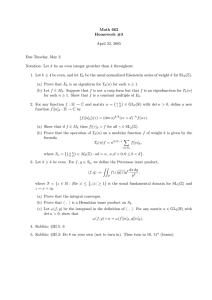Math 248B. Strong approximation in algebraic groups 1. Setup and SL
advertisement
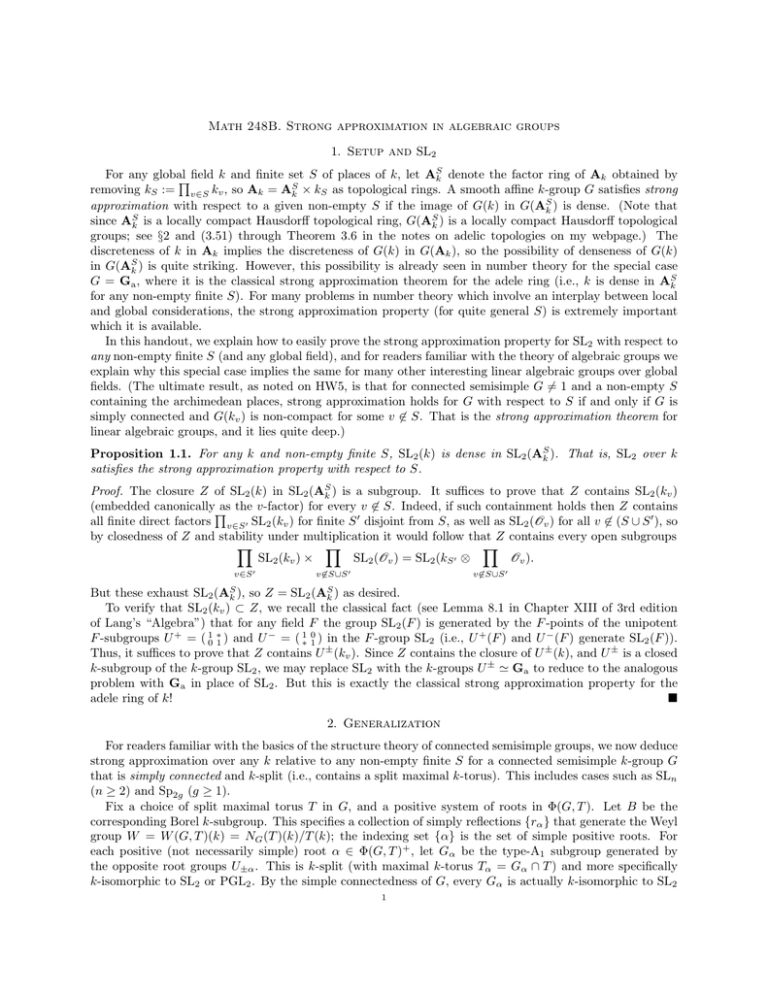
Math 248B. Strong approximation in algebraic groups
1. Setup and SL2
For any global
S of places of k, let ASk denote the factor ring of Ak obtained by
Q field k and finite set
S
removing kS := v∈S kv , so Ak = Ak × kS as topological rings. A smooth affine k-group G satisfies strong
approximation with respect to a given non-empty S if the image of G(k) in G(ASk ) is dense. (Note that
since ASk is a locally compact Hausdorff topological ring, G(ASk ) is a locally compact Hausdorff topological
groups; see §2 and (3.51) through Theorem 3.6 in the notes on adelic topologies on my webpage.) The
discreteness of k in Ak implies the discreteness of G(k) in G(Ak ), so the possibility of denseness of G(k)
in G(ASk ) is quite striking. However, this possibility is already seen in number theory for the special case
G = Ga , where it is the classical strong approximation theorem for the adele ring (i.e., k is dense in ASk
for any non-empty finite S). For many problems in number theory which involve an interplay between local
and global considerations, the strong approximation property (for quite general S) is extremely important
which it is available.
In this handout, we explain how to easily prove the strong approximation property for SL2 with respect to
any non-empty finite S (and any global field), and for readers familiar with the theory of algebraic groups we
explain why this special case implies the same for many other interesting linear algebraic groups over global
fields. (The ultimate result, as noted on HW5, is that for connected semisimple G 6= 1 and a non-empty S
containing the archimedean places, strong approximation holds for G with respect to S if and only if G is
simply connected and G(kv ) is non-compact for some v 6∈ S. That is the strong approximation theorem for
linear algebraic groups, and it lies quite deep.)
Proposition 1.1. For any k and non-empty finite S, SL2 (k) is dense in SL2 (ASk ). That is, SL2 over k
satisfies the strong approximation property with respect to S.
Proof. The closure Z of SL2 (k) in SL2 (ASk ) is a subgroup. It suffices to prove that Z contains SL2 (kv )
(embedded canonicallyQ
as the v-factor) for every v 6∈ S. Indeed, if such containment holds then Z contains
all finite direct factors v∈S 0 SL2 (kv ) for finite S 0 disjoint from S, as well as SL2 (Ov ) for all v 6∈ (S ∪ S 0 ), so
by closedness of Z and stability under multiplication it would follow that Z contains every open subgroups
Y
Y
Y
SL2 (kv ) ×
SL2 (Ov ) = SL2 (kS 0 ⊗
Ov ).
v∈S 0
v6∈S∪S 0
v6∈S∪S 0
But these exhaust SL2 (ASk ), so Z = SL2 (ASk ) as desired.
To verify that SL2 (kv ) ⊂ Z, we recall the classical fact (see Lemma 8.1 in Chapter XIII of 3rd edition
of Lang’s “Algebra”) that for any field F the group SL2 (F ) is generated by the F -points of the unipotent
F -subgroups U + = ( 10 ∗1 ) and U − = ( ∗1 10 ) in the F -group SL2 (i.e., U + (F ) and U − (F ) generate SL2 (F )).
Thus, it suffices to prove that Z contains U ± (kv ). Since Z contains the closure of U ± (k), and U ± is a closed
k-subgroup of the k-group SL2 , we may replace SL2 with the k-groups U ± ' Ga to reduce to the analogous
problem with Ga in place of SL2 . But this is exactly the classical strong approximation property for the
adele ring of k!
2. Generalization
For readers familiar with the basics of the structure theory of connected semisimple groups, we now deduce
strong approximation over any k relative to any non-empty finite S for a connected semisimple k-group G
that is simply connected and k-split (i.e., contains a split maximal k-torus). This includes cases such as SLn
(n ≥ 2) and Sp2g (g ≥ 1).
Fix a choice of split maximal torus T in G, and a positive system of roots in Φ(G, T ). Let B be the
corresponding Borel k-subgroup. This specifies a collection of simply reflections {rα } that generate the Weyl
group W = W (G, T )(k) = NG (T )(k)/T (k); the indexing set {α} is the set of simple positive roots. For
each positive (not necessarily simple) root α ∈ Φ(G, T )+ , let Gα be the type-A1 subgroup generated by
the opposite root groups U±α . This is k-split (with maximal k-torus Tα = Gα ∩ T ) and more specifically
k-isomorphic to SL2 or PGL2 . By the simple connectedness of G, every Gα is actually k-isomorphic to SL2
1
2
and the simple positive coroots α∨ : Gm → T form a basis of the cocharacter group of T . In view of the
Bruhat decomposition
a
G(k) =
B(k)wB(k),
w∈W
and the fact that W is generated by the simple reflections rα that in turn represent the nontrivial element
in W (Gα , Tα ), it follows that G(k) is generated by the subgroups Gα (k) as α varies through Φ(G, T )+ (not
just the simple roots). Thus, exactly as we reduced the strong approximation property for SL2 to the case
of Ga in the earlier proof, now the case of a general k-split simply connected G is reduced to the case of the
k-groups Gα ' SL2 .
